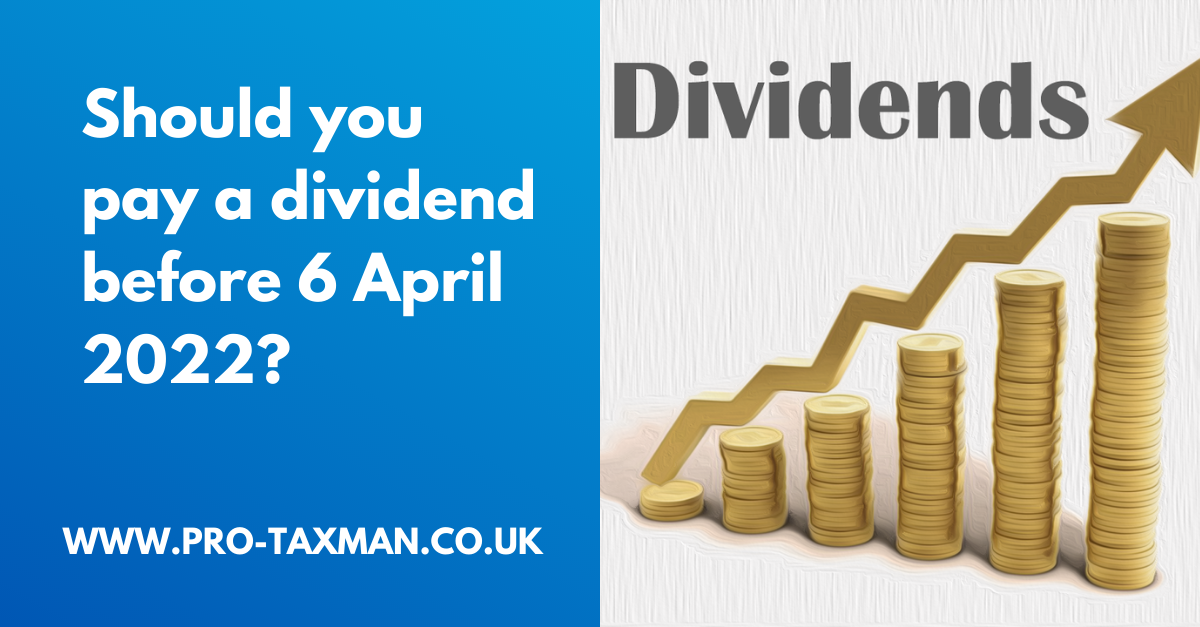If you operate your business through a personal or family company and extract profits in the form of dividends, it is prudent to review your dividend policy to determine whether it would be beneficial to pay a further dividend before the end of the 2021/22 tax year on 5 April 2022. It should be remembered, however, that dividends can only be paid if you have sufficient retained profits, and where shares of the particular class in respect of which a dividend is being declared are held by more than one shareholder, in proportion to shareholdings.
Paying a dividend before the end of the tax year may be worthwhile if:
- shareholders have unused dividend allowances; or
- to beat the dividend tax rate increases that come into effect from 6 April 2022.
Utilise dividend allowances
All individuals, regardless of the rate at which they pay tax, have a dividend allowance. This is set at £2,000 for 2021/22. The dividend allowance operates as a zero rate band and dividends (which are taxed as the top slice of income) are tax-free to the extent that are covered by the dividend allowance. However, the dividend allowance does use up part of the tax band in which it falls.
If any shareholders have not fully used their dividend allowance for 2021/22, paying a dividend to take their dividends for the tax year up to £2,000 will be beneficial allowing profits to be extracted from the company without any further liability to tax. If an alphabet share structure is used, dividends can be tailored to match the unused amount of the dividend allowance; if there is only one class of share, dividends must be paid in proportion to share holdings.
Example
Fletcher Ltd is a family company in which Bertie Fletcher and his wife Jane are directors. Bertie holds 100 A Class shares and Jane holds 100 B Class shares. The couple each take a salary, which for 2021/22 is equal to the personal allowance of £12,570. In addition, the company has declared dividends of £37,700 for both A Class and B Class shareholders.
The couple have two sons, Chris and David. Chris holds 100 C Class shares and David holds 100 D Class shares. Chris has £1,500 of his 2021/22 dividend allowance available, while David’s dividend allowance remains available in full.
To utilise the dividend allowances to extract profits free of tax, the company pays a dividend of £15 per share to C Class shareholders and a dividend of £20 per share to D Class shareholders on 30 March 2022. Chris receives a dividend of £1,500, which are covered by his available dividend allowance, and David received a dividend of £2,000, which is covered by his dividend allowance. No dividends are declared for Class and Class B shares.
Beat the dividend rate rise
As part of a package of measures to fund health and social care, the rates at which dividends are taxed are to rise by 1.25% from 6 April 2022. This will mean that for 2022/23, dividends will be taxed at 8.75% to the extent that they fall in the basic rate band (currently taxed at 7.5%), at 33.75% to the extent that they fall in the higher rate band (currently 32.5%) and at 39.35% to the extent that they fall within the additional rate band (currently 38.1%). The dividend allowance will remain at £2,000 for 2022/23.
If retained profits permit, it may be advisable to pay dividends before 6 April 2022 if doing so means that they are taxed at a lower rate than if paid after that date. However, if paying a further dividend before 5 April 2022 means that it will fall in a higher tax band than if paid after that date, it will not be beneficial – it is preferable to pay tax at 8.75% than at 32.5%.
Example
Ali is the director of his personal company A Ltd. In 2021/22 he is paid himself a salary of £9,568. He also received a dividend each year of £20,000 on 30 April. He has retained profits of £50,000. If instead of paying the dividend of £20,000 that is due to be paid on 30 April 2022, £18,000 of that dividend is paid on 30 March 2022, the tax payable will be £1,350 (£18,000 @ 7.5%) rather than £1,575 (£18,000 @ 8.75%) if the dividend is paid on 30 April 2022. The remaining £2,000 of the dividend can be paid on 30 April 2022 as planned as it will be sheltered by the dividend allowance for 2022/23.
Paying £18,000 of the dividend before 6 April 2022 to beat the tax rise will save Ali £225 in tax.
Need professional accounting service or accounting advice? Contact us to book a 15-min Free Consultation with us today.
To find out more please follow us on Facebook, Twitter, or LinkedIn. Feel free to contact us on 0333 006 4847 or request a call back by texting 075 6464 7474

